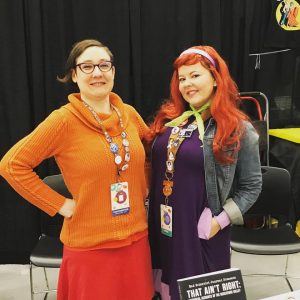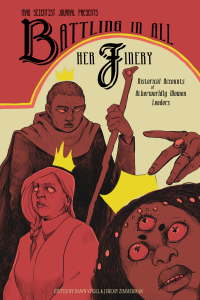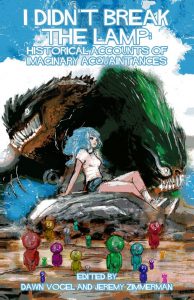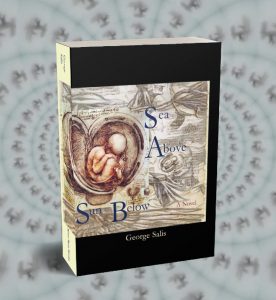An essay by Titus Rodriguez, Ph.D., as provided by G. D. Watry
Art by Leigh Legler
Abstract: For decades, myriad parapsychologists have pondered the role of so-called “imaginary companions” (IC) in cases concerning poltergeist activity. Though we may theorize the rhyme and reason for it, children appear to amplify the poltergeist presence. Indeed, our own lab’s case studies, localized to the northwest pocket of New Jersey, indicate a positive correlation between quantifiable poltergeist activity and the presence of a child or children in the studied household.
In our experience, the events follow a trajectory. New occupants move into the house and an IC manifests. It induces interaction with the child or children. Cumulative contact appears to be key here, for each interaction strengthens the psychic bond between IC and adolescent/s. We’ve termed this relationship “cerebral parasitism,” and its effects are not limited to the psychological. Physical illness and disturbances often follow. Poltergeist activity crescendos. Pranks that were once innocuous turn perilous, and occupants often report experiencing psychological and physical torment at the behest of unseen beings. The Mayfield family may have been such a case.
Gwen Mayfield contacted the Rodriguez Lab on the morning of March 19, 2015, following what she believed to be a botched abduction of her son Tobias by an entity she called “the skitterer.” Ms. Mayfield and her son had recently moved into a new house at 8474 La Vela Avenue in the Borough of Sussex on March 14, 2015, following a falling out with her partner Arnold Recker, a known affiliate of The Coyote Moon (SEE INDEX ITEM “COYOTE MOON, THE; CULT”). The Coyote Moon boasts strong membership in the Borough of Sussex region, with members of the commune active in both municipal and policing roles.
After contact, the team performed an exploratory interview with Ms. Mayfield on March 21, 2015. The following is an audio transcript from that interview, which ended, to our displeasure, in an abrupt manner. Unfortunately, we were unable to schedule a follow-up interview with Ms. Mayfield. She and her three-year-old son Tobias disappeared. They were last seen by their neighbor Mrs. Lupe Galvan on the night of March 22, 2015. Mrs. Galvan recalled seeing the mother and child sitting silently in their backyard, “their hands clasped together as if in prayer and their heads upturned in deference towards the moon.”
We are at a loss, and this is an appeal for assistance.
~
[Selections from the audio transcript of Dr. Titus Rodriguez’s interview with Gwen Mayfield on March 21, 2015]
TR: And that’s when you noticed the crib was empty?
GM: H-he, he just wasn’t there anymore. I must’ve shut my eyes for just a second, but that’s all it took. One second, I’m lost in the grainy light from the baby monitor app on my iPhone, watching Tobe’s body rise and fall with his breath, and the next, I’m jolted awake, kicking back the grip of sleep, and he’s gone. The crib is empty, and he’s gone.
TR: And what did you do next?
GM: What did I do next? Jesus. You’re not a parent are you, doc?
TR: [No response.]
GM: I shot out of bed and looked like hell for him is what I did next. Nearly broke my ankle slipping on the hallway’s Persian carpet while sprinting to his room.
TR: Was he in there?
GM: What? No, no he wasn’t in there. Are you even listening?
TR: Apologies, Ms. Mayfield. I am listening. Continue.
GM: The crib was empty, but the jungle mobile above it played its jingle, a toy piano version of “Ring Around the Rosy.” The mobile activates via motion sensors, so something must’ve kicked it into gear. But it wasn’t Tobe. I’m sure of that. For a moment, I couldn’t move. I just stood there, watching the plush lions chase the monkeys round and round the four-leaf canopy. When I originally bought the mobile, I thought it was cute. But two nights ago, it just seemed–fierce. The lions bared their teeth, and the monkeys–oh, god—their faces. [Long pause.]
TR: How long did it take you to find Tobias in the driveway?
GM: [Sniffs. Coughs.] Probably 20 minutes. I tore the house apart; I mean, it’s not big a place, so there aren’t many places to look, and we’re practically still living out of boxes. I was checking again for him under the kitchen table when I noticed the door to the garage was open. Through the crack in the door, I could see the lawn lights from the house across the street.
TR: Why were you looking for Tobias under the kitchen table?
GM: It’s his favorite spot for hide-and-seek.
TR: Was it unusual that the door to the garage was open?
GM: Very. I always keep it locked. All the doors actually. Ever since the incident with Arnold.
TR: And that would be Arnold Recker?
GM: Yes, but as I said on the phone, we’re not discussing that.

Long-limbed and waxing, it always looks as if it’s rising above the forest, its snouted face as luminous as the moon.
To read the rest of this story, check out the Mad Scientist Journal: Autumn 2019 collection.
Titus Rodriguez, Ph.D., is a research scientist at a stealth startup in the Hudson Valley. Before jumping to industry, he was a faculty member at The Barron Institute’s Center for Cognitive Psychology and Behavioral Neuroscience.
G. D. Watry is a writer from California. His work has appeared in Pantheon Magazine, Hinnom Magazine, OCCULUM, Shotgun Honey, Third Flatiron Publishing, and The Molotov Cocktail, among other publications. You can find him on Twitter @GDWatry.
Leigh’s professional title is “illustrator,” but that’s just a nice word for “monster-maker,” in this case. More information about them can be found at http://leighlegler.carbonmade.com/.
“The Skitterer” is © 2019 G. D. Watry
Art accompanying story is © 2019 Leigh Legler








